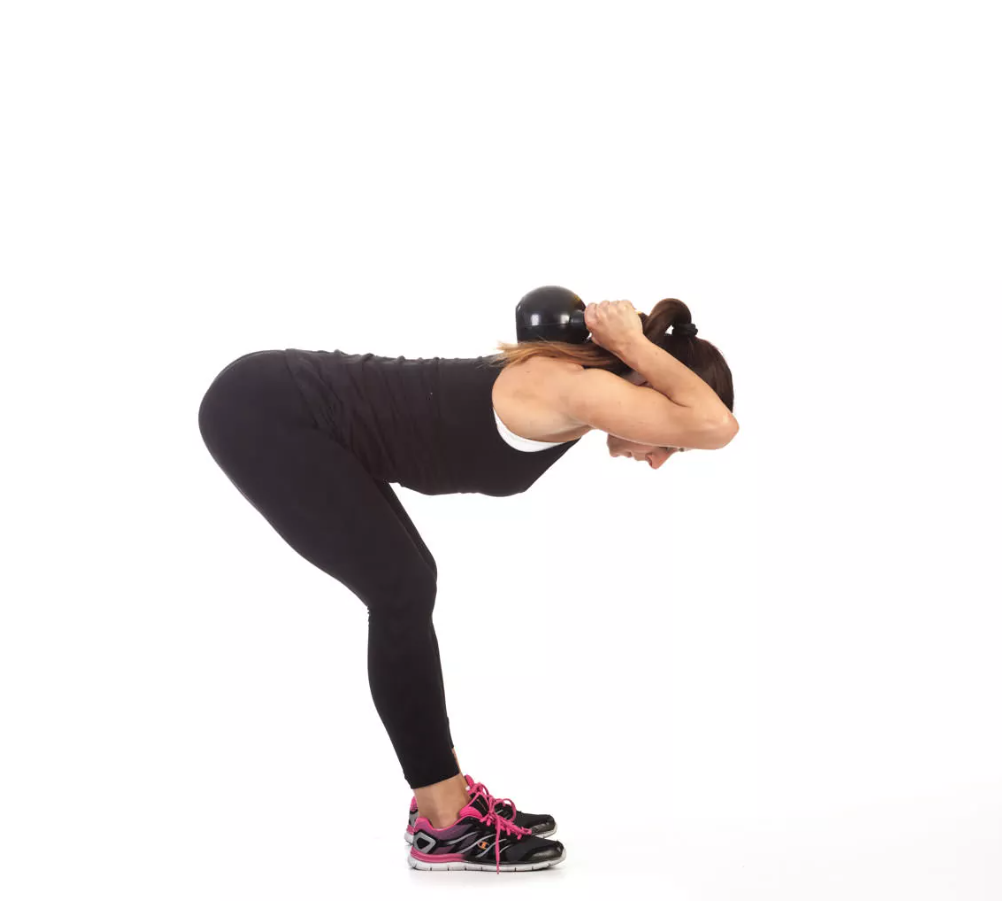In the realm of strength training, the Good Morning exercise stands out as a versatile and effective movement that targets key muscle groups crucial for overall fitness. This exercise, often overlooked, plays a vital role in enhancing strength and flexibility simultaneously. As we delve into the comprehensive guide, we'll explore the various dimensions of the Good Morning exercise, from its benefits to detailed techniques, variations, and practical tips for seamless integration into your workout routine. However, today, we're going to focus specifically on one of its dynamic variations that truly takes your workout to the next level: the Kettlebell Good Morning. This variation not only amplifies the benefits of the traditional Good Morning but also adds an extra dimension of challenge and refinement to your training regimen. Join us as we uncover the secrets behind mastering the Kettlebell Good Morning for enhanced strength, flexibility, and overall fitness.
Benefits of the Kettlebell Good Morning Exercise
Strengthening the Lower Back
The erector spinae, a group of muscles along the spine, plays a pivotal role in maintaining an erect posture and supporting the lower back. Studies, such as those by McGill (2002) in "Low Back Disorders: Evidence-Based Prevention and Rehabilitation," have demonstrated that targeted exercises like the Kettlebell Good Morning effectively engage and strengthen these muscles. This not only promotes a resilient lower back but also contributes to spinal stability, reducing the risk of lower back disorders.
Engaging Hamstrings and Glutes
The Kettlebell Good Morning places significant emphasis on the posterior chain, involving the hamstrings and glutes in a coordinated effort. According to Contreras (2013), a renowned fitness expert, this engagement not only fosters muscle growth and development but also enhances the overall stability of the hip joint. The exercise's effectiveness in targeting these muscle groups has made it a staple in strength training programs focused on functional movements.
Improving Hip Mobility
The hip hinge motion intrinsic to the Kettlebell Good Morning serves as a natural mechanism for improving hip mobility. Saeterbakken and Fimland (2013)found in their research that exercises emphasising the hip hinge pattern contribute to increased hip range of motion. Improved hip mobility is not only beneficial for daily activities but also translates to enhanced athletic performance and reduced injury risk.
Functional Movement Pattern
One of the unique aspects of the Kettlebell Good Morning is its mimicry of a fundamental movement pattern used in daily activities like picking up objects from the ground or tying shoelaces. Dan John, a renowned strength coach, emphasises the importance of incorporating such functional movements into training programs for real-world applicability (John, 2016). The Kettlebell Good Morning, with its focus on a natural and functional range of motion, aligns perfectly with this principle.
Which Muscles Does the Kettlebell Good Morning Work On?

The Kettlebell Good Morning exercise is a compound movement that primarily targets the muscles of the lower back, hamstrings, and glutes. Let's delve into each muscle group in detail:
Erector Spinae (Lower Back Muscles)
Anatomy
- The erector spinae muscles run along the spine's length, comprising the iliocostalis, longissimus, and spinalis.
- Originating from the sacrum and pelvis, these muscles ascend vertically along the spine, providing support and stability.
Engagement during Kettlebell Good Mornings
- The erector spinae muscles play a crucial role in maintaining an erect posture during the Kettlebell Good Morning.
- As you hinge at the hips and lower your torso, these muscles are actively engaged to resist forward flexion and stabilise the spine.
Benefits
- Strengthening the erector spinae contributes to improved posture and reduces the risk of lower back disorders.
- Increased erector spinae strength enhances spinal stability during various daily activities and athletic movements.
Hamstrings
Anatomy
- Comprising three muscles (biceps femoris, semitendinosus, and semimembranosus), the hamstrings run along the back of the thigh.
- Originating from the ischial tuberosity (sit bones), these muscles extend downward and insert at various points on the tibia and fibula.
Engagement during Kettlebell Good Mornings
- The hamstrings are actively engaged during the hip hinge motion of the Kettlebell Good Morning.
- As you lower your torso, the hamstrings lengthen, and during the ascent, they contract to pull your torso back to an upright position.
Benefits
- Kettlebell Good Mornings effectively target and strengthen the hamstrings, contributing to improved knee stability and overall lower body strength.
- Developing strong hamstrings is crucial for athletic performance, especially activities that involve running, jumping, and changing directions.
Gluteus Maximus
Anatomy
- The gluteus maximus is the largest muscle in the buttocks and is responsible for hip extension.
- It originates from the posterior ilium and sacrum and inserts into the femur's greater trochanter.
Engagement during Kettlebell Good Mornings
- The gluteus maximus is highly engaged during the upward phase of the Kettlebell Good Morning.
- As you return to an upright position, the glutes contract to extend the hips, contributing to the movement's power.
Benefits
- Strengthening the gluteus maximus enhances hip stability and contributes to improved overall lower body strength.
- Developed glutes play a pivotal role in functional movements, including standing up from a seated position and maintaining balance.
Quadratus Lumborum
Anatomy
- The quadratus lumborum is a deep muscle located on each side of the lumbar spine.
- It originates from the iliac crest and inserts into the transverse processes of the lumbar vertebrae and the twelfth rib.
Engagement during Kettlebell Good Mornings
- The quadratus lumborum is engaged as a stabiliser during the hip hinge motion.
- It works alongside the erector spinae to provide lateral stability to the spine.
Benefits
- Strengthening the quadratus lumborum supports spinal stability and helps prevent lateral flexion during movements like the Kettlebell Good Morning.
- Improved quadratus lumborum strength contributes to better overall core stability.
Abdominals (Rectus Abdominis and Transverse Abdominis)
Anatomy
- The rectus abdominis is the "six-pack" muscle, running vertically along the anterior abdomen.
- The transverse abdominis is a deeper muscle that wraps around the torso, providing core stability.
Engagement during Kettlebell Good Mornings
- The abdominals are engaged to stabilise the core throughout the Kettlebell Good Morning movement.
- Bracing the core prevents excessive spinal flexion and ensures proper alignment.
Benefits
- Strengthening the abdominals contributes to improved core stability and spinal support.
- A stable core enhances overall athletic performance and reduces the risk of lower back injuries.
Understanding the detailed engagement of these muscles during the Kettlebell Good Morning exercise provides valuable insight into its effectiveness in targeting key muscle groups. Proper form and technique are essential to maximising the benefits and minimising the risk of injury during this dynamic strength training movement.
Detailed Technique and Form
Understanding the nuances of the Kettlebell Good Morning's technique is crucial for reaping its full benefits while minimising the risk of injury. Let's break down the key elements of proper execution:
Starting Position
Establishing a solid starting position is foundational for the Kettlebell Good Morning. Stand with your feet shoulder-width apart, ensuring a balanced and stable foundation. If using a kettlebell, hold it securely with both hands in front of your body.
Bracing the Core
The core plays a pivotal role in stabilising the spine during the Kettlebell Good Morning. Engage your core muscles before initiating the movement. This bracing not only supports the lower back but also facilitates a controlled and effective transfer of energy throughout the exercise.
Hinging at the Hips
The hallmark of the Kettlebell Good Morning is the hip hinge, a controlled forward movement initiated at the hips. Imagine pushing your hips backward, as if closing a car door with your backside. This deliberate hip hinge ensures that the stress is placed on the intended muscle groups, primarily the erector spinae, hamstrings, and glutes.
Lowering the Torso
As you hinge at the hips, lower your torso forward while maintaining a straight back. The depth of the descent depends on individual flexibility and comfort. It's essential to avoid rounding your back, which could compromise the integrity of the movement and increase the risk of injury.
Returning to the Starting Position
To complete the Kettlebell Good Morning, engage your hamstrings and glutes to lift your torso back up, returning to the upright position. Ensure that your back remains straight throughout the entire movement. This controlled ascent is crucial for maximising the benefits of the exercise.
Understanding and mastering each aspect of the Kettlebell Good Morning's technique is a gradual process that requires attention to detail and consistent practice. As with any strength training exercise, the quality of movement should always take precedence over the quantity of weight lifted.
Common Mistakes and Corrections
Even with a seemingly straightforward movement like the Kettlebell Good Morning, certain common mistakes can compromise its effectiveness and safety. Let's explore these pitfalls and how to correct them:
Rounding the Back
One of the most prevalent mistakes in the Kettlebell Good Morning is allowing the back to round during the descent. This compromises the spinal integrity and shifts the focus away from the intended muscle engagement. To correct this, focus on maintaining a straight back throughout the entire range of motion. Engage the core muscles and visualise keeping your spine in a neutral position.
Locking the Knees
Locking out the knees at any point during the exercise can lead to undue stress on the joints. To prevent this, maintain a slight bend in the knees throughout the movement. This ensures that the stress is distributed to the targeted muscle groups rather than concentrating on the knee joints.
Insufficient Core Engagement
A weak or inactive core diminishes the stability of the entire movement. Correct this by prioritising core engagement from the starting position through the descent and ascent phases. This not only enhances the efficacy of the exercise but also safeguards the lower back.
Overextending the Range of Motion
While hip mobility is a key benefit of the Kettlebell Good Morning, overextending the range of motion beyond individual flexibility can lead to improper form. To address this, focus on a controlled and gradual descent, respecting your body's natural range of motion. As flexibility improves over time, you can incrementally increase the depth of the movement.
By being mindful of these common mistakes and implementing the suggested corrections, individuals can ensure that each Kettlebell Good Morning repetition contributes to their overall strength and flexibility without compromising safety.
Variations of the Kettlebell Good Morning
While the traditional Kettlebell Good Morning is a powerful exercise, incorporating variations can add diversity to your training routine and target muscles from different angles. Let's explore three noteworthy variations:
Offset Kettlebell Good Morning
It Involves holding a kettlebell in one hand while performing the exercise.It increases the challenge to the core and stabilizing muscles on one side of the body and helps improve balance and coordination.
Elevated Heel Kettlebell Good Morning
This exercise is Performed with the heels elevated on a small platform or weight plates. It Increases the range of motion and places greater emphasis on the hamstrings and glutes. It also provides a deeper stretch in the posterior chain muscles.
Single-Leg Kettlebell Good Morning
This unilateral variation enhances balance and stability while isolating each leg's muscles. The Single-Leg Kettlebell Good Morning demands increased engagement from the stabilising muscles and is particularly beneficial for athletes seeking improved proprioception and functional strength.
Incorporating these variations into your training regimen offers a well-rounded approach to strength development and ensures continual progression. As with any new exercise, start with lighter resistance and gradually increase as your proficiency improves.
Incorporating the Kettlebell Good Morning Into Your Routine
Effectively integrating the Kettlebell Good Morning into your workout routine requires thoughtful planning and consideration of various factors. Let's explore how to seamlessly incorporate this exercise into your training regimen:
Frequency and Volume
The frequency at which you perform Kettlebell Good Mornings depends on your fitness level, goals, and overall workout structure. For beginners, incorporating this exercise 1-2 times per week is sufficient. Advanced lifters might include it more frequently, but always prioritise adequate recovery.
Pairing with Other Exercises
Pairing Kettlebell Good Mornings with complementary exercises enhances the effectiveness of your training session. Consider combining them with compound movements like squats or deadlifts to create a comprehensive lower body workout. Alternatively, pairing with core exercises fosters overall stability.
Diversify your workout routine by integrating a variety of kettlebell types, enhancing both versatility and impact. Opt for Adjustable Kettlebells for adaptable resistance, Competition Kettlebells adhering to professional standards, or Powder Coat Kettlebells prized for their enduring strength and enhanced grip. Tailored to your fitness aspirations, each type presents distinct advantages, amplifying your exercise experience.
Safety Considerations
Ensuring safety during Kettlebell Good Mornings involves attention to form, gradual progression, and listening to your body. Let's delve into key safety considerations:
Gradual Progression
Gradually progressing the intensity of your Kettlebell Good Morning workouts is crucial for preventing injuries. Begin with bodyweight or light resistance and incrementally increase the load as your strength improves. Sudden jumps in weight can strain the lower back and hamstrings.
Listening to Your Body
Pay close attention to how your body responds to each repetition. Discomfort in the lower back or sharp pains are warning signs. If you experience any issues, reassess your form, reduce the weight, or consult with a fitness professional.
Sample Kettlebell Good Morning Workout
To provide a practical application of the Kettlebell Good Morning exercise, here's a sample workout routine:
Warm-up
- Five minutes of light cardio (e.g., brisk walking or jumping jacks).
- Dynamic stretches targeting the hamstrings, glutes, and lower back.
Main Workout
- Exercise 1: Bodyweight Kettlebell Good Morning
- 3 sets x 12 reps
- Focus on controlled movement and full range of motion.
- Exercise 2: Dumbbell or Kettlebell Kettlebell Good Morning
- 4 sets x 10 reps
- Gradually increase the weight with each set.
- Exercise 3: Single-Leg Kettlebell Good Morning
- 3 sets x 10 reps per leg
- Engage the core for balance.
Cool Down
- Five minutes of static stretching, targeting the hamstrings, glutes, and lower back.
- Deep breathing exercises for relaxation.
Conclusion
Incorporating the Kettlebell Good Morning into your fitness routine offers a multitude of benefits, from strengthening the lower back to engaging key muscle groups critical for functional movement. By understanding the proper technique, avoiding common mistakes, exploring variations, and incorporating safety considerations, you can harness the full potential of this underrated exercise.
Whether you're a beginner looking to build a solid foundation or an experienced lifter seeking to diversify your workouts, the Kettlebell Good Morning provides a versatile and challenging addition to your strength training arsenal. Remember to progress at your own pace, prioritise form over weight, and stay attuned to your body's signals.
As you embark on your Kettlebell Good Morning journey, consider consulting with a fitness professional for personalised guidance. With consistent practice and a well-structured training plan, the Kettlebell Good Morning can become a cornerstone of your strength and flexibility development, contributing to a more robust and resilient physique.
References:
- McGill, S. M. (2002). Low Back Disorders: Evidence-Based Prevention and Rehabilitation.
- Contreras, B. (2013). The Hip Thrust: A New Foundation for Performance.
- Saeterbakken, A. H., & Fimland, M. S. (2013). Effects of Body Position and Loading Modality on Muscle Activity and Strength in Shoulder Presses.
- John, D. (2016). Train the 5 Basic Human Movements.










